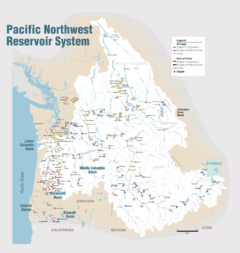| Ice Harbor Dam | |
|---|---|
 Aerial view from northwest | |
Location in Washington | |
| Country | United States |
| Location | Franklin and Walla Walla counties, Washington |
| Coordinates | 46°15′N 118°53′W / 46.25°N 118.88°W |
| Construction began | June 1955 |
| Opening date | 1962[1] |
| Owner(s) | U.S. Army Corps of Engineers |
| Dam and spillways | |
| Type of dam | Concrete gravity |
| Impounds | Snake River |
| Height | 100 feet (30 m) |
| Length | 2,822 feet (860 m) |
| Spillway type | Service, gate-controlled |
| Reservoir | |
| Creates | Lake Sacajawea |
| Total capacity | 249,000 acre⋅ft (0.307 km3)[2] |
| Surface area | 8,375 acres (33.89 km2) |
| Normal elevation | 443 feet (135 m) AMSL |
| Power Station | |
| Type | Run-of-the-river |
| Turbines | 3 x 90 MW units; 3 x 111 MW units[3] |
| Installed capacity | 603 MW 693 MW (max) |
 | |
Ice Harbor Lock and Dam is a hydroelectric, concrete gravity run-of-the-river dam in the northwest United States. On the lower Snake River in southeastern Washington, it bridges Walla Walla and Franklin counties.[4] Located eight miles (13 km) northeast of Burbank and twelve miles (19 km) east of Pasco, river mile 9.7, the dam's name comes from a tiny bay in the river where boats once tied up to wait for upstream ice-jams to break up.[5]
Construction began in June 1955; the main structure and three generators were completed 63 years ago in 1961,[6] with an additional three generators finished in 1976. Generating capacity is 603 megawatts, with an overload capacity of 693 MW. The spillway has ten gates and is 590 feet (180 m) in length.
- ^ "Ice Harbor Dam brought big boats back to Snake River". Tri-City Herald. June 17, 1975. p. 26.[permanent dead link]
- ^ "The Four Lower Snake River Dams". Bluefish.org. Retrieved 17 July 2010.
- ^ "Ice Harbor Dam". Washington.edu. Retrieved 17 July 2010.
- ^ "The Columbia River System Inside Story" (PDF). BPA.gov. pp. 14–15. Archived from the original (PDF) on 27 May 2010. Retrieved 17 July 2010.
- ^ "Ice Harbor Dam". Washington Place Names database. Tacoma Public Library. Archived from the original on 2009-03-09. Retrieved 2009-03-06.
- ^ "Ice Harbor is first step in taming of lower Snake". Lewiston Morning Tribune. July 16, 1961. p. 13.

